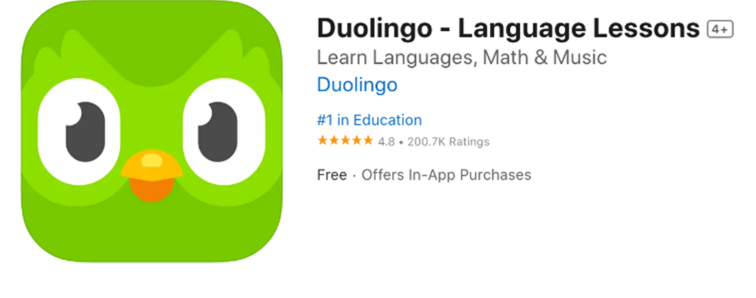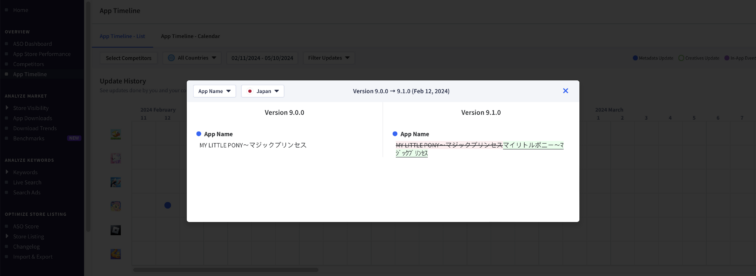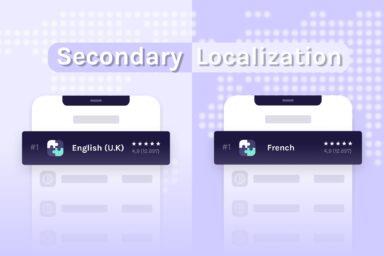App Name for iOS Apps: How to Optimize Your App Title For More Downloads and High-Impact ASO
An app’s name is critical to strategic app store optimization (ASO) and overall success. It significantly impacts organic rankings in App Store’s search results and brand perception, requiring app marketers to strike the right balance between technical and user relevance. This guide will help you achieve this goal.

Where does app name appear across Apple's ecosystem?
Your app name appears in multiple critical locations throughout the App Store, each directly impacting discoverability and conversion rates for ASO purposes:
- Search Results – Most crucial placement where your full character name appears prominently above the subtitle, heavily weighted by the search algorithm for keyword relevance
- Category and Browse Pages – App name displays in category listings where users compare multiple apps simultaneously, requiring clear differentiation from competitors
- Today Tab Editorial Features – Appears in story cards, collections, and spotlight features with varying truncation based on design requirements
- App Product Pages – Complete name displays at the top as primary identifier for users evaluating download decisions
- Related Apps Sections – Shows in “You Might Also Like” recommendations where algorithmic placement relies on keyword relevance and category positioning
- Developer Profile Pages – All your apps display with full names, creating cross-promotion opportunities and brand consistency requirements
- Charts and Rankings – Appears in top charts and category rankings in condensed formats where brevity and clarity become critical for user scanning
Understanding these display contexts helps inform strategic decisions about keyword placement, character usage, and overall naming approach to maximize visibility across the App Store ecosystem.
Technical guidelines for app names on the App Store
The app name displayed on the App Store has a limit of 30 characters. Generally, app store names can include alphanumeric characters (A-Z, a-z, 0-9) and spaces. Punctuation marks are also allowed and frequently used. Special characters and capitalizations are also permitted, but we’d advise thoughtful use. The search feature isn’t case sensitive.

A typical app name is simple, consisting of a unique name with a brief description. Special characters are sometimes used.
App names must accurately represent the app’s functionality and content. Using names that could mislead users into downloading the app is prohibited. Additionally, don’t use trademarked terms, popular app names, pricing information, or phrases irrelevant to the app or game.
Carefully consider your app’s name, as it can be updated with a new app submission or an update.
How does app name impact organic rankings in App Store?
App name is the most important organic ranking factor, making the probability of appearing higher in search results for keywords included than in the subtitle and keyword fields. This means that following our guidelines, you’ll be able to gain visibility for the following keywords:
- A unique word is your brand name: Bumble, TikTok, Temu, Lyft, Duolingo, etc.
- A strategic, core feature: free photo app, gardening, RPG, arcade, PvP, multiplayer, etc.
Following this principle is critical in the long run, even for a new app whose unique name may have little recognition and no related search traffic. Paid user acquisition or any app marketing activity will ultimately lead to a bigger prominence of branded search terms used by people looking specifically for your app.

A collection of apps from the App Store, showing how the app’s name and subtitle complement each other. Source: App Store.
Consequently, branded search terms become among the most valuable ones in terms of cost per download, tap-through, and conversion rates.
Most apps follow this pattern, but mobile games tend to include unique word patterns as well.
Tip: From organic rankings perspective, an app name is a long term investment that should focus on the most relevant keywords, taking priority over search term popularity and ranking difficulty. There’s always room for improvement and optimization, but always within confines of precision and relevance.
To wrap up, from an organic ranking perspective, focus on app name clarity: a good app name tells users what the app does at a glance. This clarity can lead to more informed downloads, as users are more likely to download an app if they understand its purpose. For instance, an app named “Easy Recipe Finder” clearly indicates its function. Additionally, a unique keyword will benefit your rankings and organic traffic in the future.
Remember, a comprehensive approach is recommended for allocating keywords between the app’s name, subtitle, and the keyword field. Avoid duplication and adhere to the best practices for each metadata field.
App name and brand perception
An app’s name is simultaneously one of the most critical factors impacting brand perception and awareness. A unique, simple, and easy-to-remember name will be more likely to be searched on the App Store than one that does not meet these criteria.
Having a unique name can only help your brand awareness efforts. It makes your app not only more memorable but also more searchable. When people search for your app on a search browser or a social media platform, your app rather than other random results will show up.
To sum up, from a brand awareness standpoint, a perfect app name should meet the following criteria:
- Clarity: A precisely stated function or theme will build the proper association with your unique brand name.
- Memorability: A concise and catchy name is easier for users to remember and share with others. This can contribute to organic growth through word-of-mouth.
- Stand out: In a crowded app marketplace, a unique and relevant name can help your app stand out from the competition.
How do you update and change your app name?
App name changes can only be made when submitting a new app version or update, requiring you to go through Apple’s standard review process before the new name appears on the App Store.
App name upadate process looks like this:
- Create New Version – Navigate to App Store Connect, select your app, and create a new version by clicking the “+” button next to your platform
- Access App Information – Go to the “App Information” section in the left-hand menu where you can edit the name field directly
- Enter New Name – Update the app name field ensuring it meets Apple’s 30-character limit and follows App Store Review Guidelines
- Submit for Review – Save changes and submit the update for Apple’s review process, which applies to both the app update and name change
Things to consider regarding timing and impact of app name changes:
- No Immediate Changes – Live apps cannot change names instantly; you must create and submit a new version even if only changing the name
- Ranking Continuity – Existing organic rankings may be affected during the transition as Apple’s algorithm adjusts to the new name
- Review Timeline – Factor in standard App Store review times (typically 24-48 hours) when planning name changes for marketing campaigns or rebrand launches
- One-Time Opportunity – Each app submission allows only one name change, so ensure thorough testing and validation before submitting
The strategic timing of name updates should align with broader ASO goals, as the change impacts all existing search rankings and brand recognition built under the previous name.
How do Apple Ads and app names work together?
Your app name directly impacts Apple Ads campaign performance, as the search ads algorithm uses your App Store metadata, including the app name, to automatically match your ads to relevant searches.
This is why proactive, brand awareness-building promotion can improve the traction of branded keywords, a key reason to consider creating a multi-placement ad strategy in Apple Ads, for example.
Understanding how your app name functions within Apple’s paid advertising ecosystem is crucial for campaign optimization and cost efficiency.
- Brand Campaigns – Your app name becomes the primary keyword for brand campaigns, typically delivering the lowest cost-per-install and highest conversion rates
- Search Match Integration – Apple’s Search Match feature automatically uses your app name keywords to match ads to relevant searches, expanding reach beyond manually selected keywords
- Keyword Relevance Scoring – Keywords already present in your app name receive higher relevance scores in paid campaigns, potentially lowering your cost-per-tap
- Campaign Structure – Organize separate campaigns for brand keywords (your app name), category keywords, and competitor keywords for better optimization and reporting
ASO and paid campaign synergy
The strategic coordination between organic optimization and Apple Ads creates compounding performance benefits across both channels.
- Keyword Discovery – Use Apple Ads data to identify high-performing search terms, then optimize your organic app name and subtitle around successful paid keywords
- Ranking Reinforcement – Running paid campaigns for keywords in your app name can boost organic rankings for those same terms through increased downloads and engagement
- Cost Efficiency – Apps with well-optimized names containing relevant keywords often see 20-30% lower cost-per-install in Search Ads due to improved relevance matching
- Performance Testing – Test keyword variations in paid campaigns before committing to app name changes, using Search Ads as a validation tool for ASO decisions
The strategic alignment between your organic app name optimization and Apple Ads keyword strategy creates compounding benefits for both paid and organic discovery.
How do app names impact editorial, app featuring eligibility?
App names play a crucial role in Apple’s editorial selection process, as they directly influence how your app appears in premium placements like the Today tab, Editor’s Choice, and themed collections – also known as app featuring.
Editorial display and format
Apple’s editorial features showcase app names in streamlined, highly visible formats designed for maximum impact and user clarity.
- Today Tab Placement – Features simplified format displaying app icon, name, and subtitle directly from App Store Connect, appearing prominently on the App Store’s front page
- Editor’s Choice Badge – Selected apps receive permanent badge placement across all platforms, with app name serving as primary identifier in curated collections
- Themed Collections – App names appear in seasonal and topical groupings where clear, descriptive naming helps users understand relevance to the collection theme
- Story Features – Editorial stories showcase apps with names prominently displayed alongside curated content and developer spotlights
Editorial selection criteria
Apple’s editorial team prioritizes apps that demonstrate quality through every aspect of their App Store presence, starting with the app name.
- Quality Standards – Editorial team seeks apps with professional, clear names that accurately represent high-quality, regularly updated applications
- Brand Consistency – Names that align with overall app quality, visual design, and user experience receive stronger editorial consideration
- Nomination Process – Developers can submit apps for featuring through App Store Connect, with app name serving as key element in editorial review
- Content Guidelines – App names must adhere to Today tab content guidelines and Apple Advertising Policies for premium placement eligibility
Apps with clear, memorable, and professionally crafted names significantly increase their chances of editorial selection and feature placement across Apple’s curated sections.
Best practices for creating app names
Here’s a list of best practices from App Radar’s team to help you create an app name that is clear, memorable, and stands out on the App Store.
Add a unique word
From an ASO perspective, finding the right unique word for your name ensures that:
- No one else has an app with the same name
- The URL for your app’s website is not yet taken
- The social media handles for your app’s name are not yet taken
Once you have a few ideas for what your app’s name could be, check the following points:
- Is it easy to pronounce for your target audience?
- Is it understandable and culturally relevant for your target audience?
- Is it spelled correctly? (It’s better to use “shoes” and not “shoez”)?
Then, run it by people who would be in your target audience. These can be your friends, family, work colleagues, or even professional A/B testing, which is possible before the app is released.
Test your app name, even before the app is released
It’s impossible to set a definitive guideline, as your creativity is the only limit in this instance. Remember to confront your ideas with the real world by following the steps above. App Radar’s vast market intelligence features will be beneficial at this stage, although sometimes even a simple Google, Bing, or App Store search can give you a general idea of how good your pick is.
An app’s name can be tested long before it is released, as early as its prototyping stage, when it’s nothing more than a few sketches pinned to your board with some magnets. SplitMetrics Optimize is a platform that allows such experiments, helping developers make creative decisions that match market reality.
Select a core feature or theme
Secondly, your app name tells potential users what your app is about. The name should be related to your app’s category, theme, or features and include the highest-priority keywords.
Proper keyword research is essential to this step, as you need to find relevant keywords with the highest potential for driving users to your product page and, preferably, the ability to rank for them among your competitors.
App Radar’s AI-driven keyword research feature will be indispensable here, as the platform greatly expands organic metrics and insights found in other official platforms and services, like App Store Connect.
Moreover, choosing an app name is a crucial aspect of running ASO competitive research. In this case, App Radar also comes to help, offering unique features at general and granular levels for comprehensive ASO market research, like the App Creatives Library, ASO Benchmarks, and App Timeline.

App Radar shows you a “before” and “after” comparison of metadata changes made on a specific date for the particular locale. Here, we can track changes made to a competitor’s app name.
Consider the subtitle and keyword field
Implementing category keywords (related to your app’s functionality or theme) in the app name should be strategically coordinated with the two other metadata fields that impact organic rankings: the subtitle and keyword fields.
Remember to focus on the core feature of your name and relegate secondary keywords to the other two. Also, remember the impact of the subtitles on perception.
Consider the subtitle while you design your ideal app name. This will help you create brand awareness and invoke positive associations with your app.
Localize
A unique word, the name of your app, will be unchanged on most markets. The practical part of your app’s name should be localized. Duolingo is Duolingo on every single market. But in the USA it’s “Duolingo – Language Lessons” and in Germany “Duolingo – Sprachkurse”.
Final words
A good understanding of your app’s themes and functionality, audience, competitors, diligent research, and creative spark make a perfect app name. For best results, assume that it’s a long-term investment, both for app store optimization (ASO) and building brand awareness. App Radar’s suit of services will provide you with data & market insights necessary to make that investment successful.
Latest Posts

iOS App Product Page Localization: How to Use it the Right Way to Improve ASO
Top 10 Most Downloaded Games in Google Play Store (July 2025 Update)
Google Play Store Listing Experiments: How to Run Native A/B testing for Android Apps for Free!
12 Best Mobile Measurement Partners (MMPs) to Consider for Your Mobile App Attribution in 2025
Academy Lessons
Continue lessons

